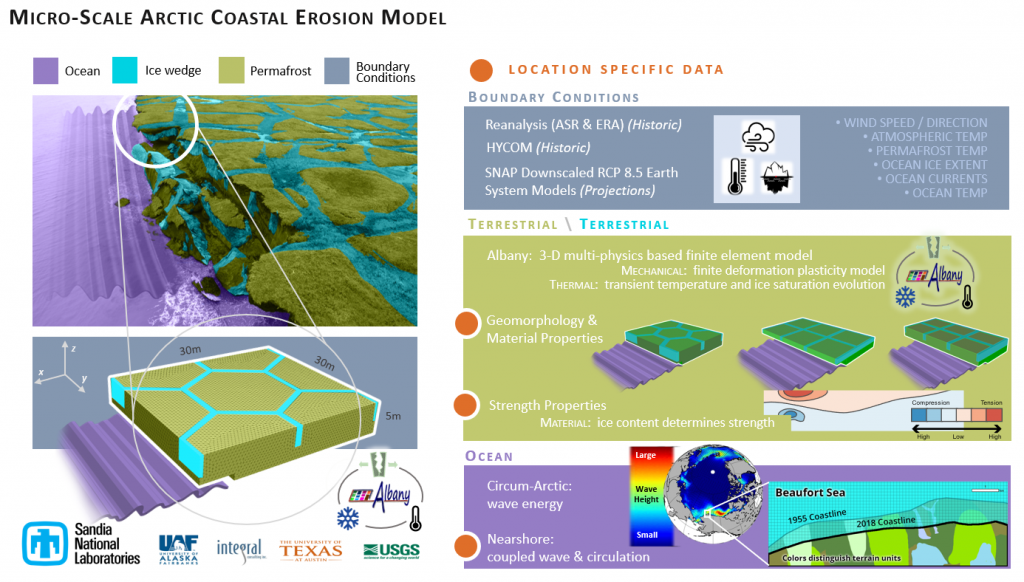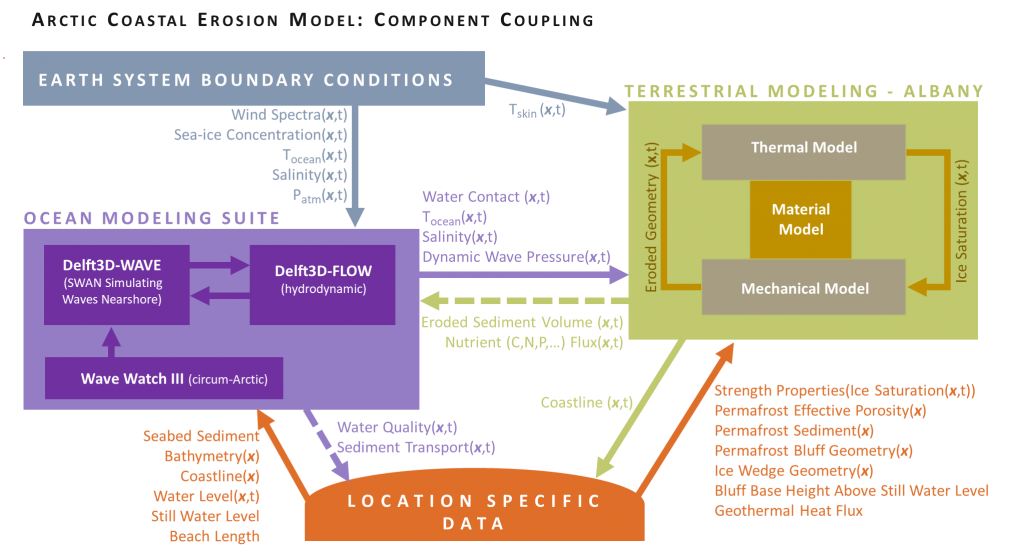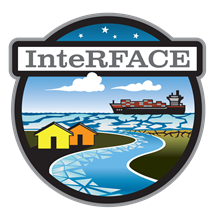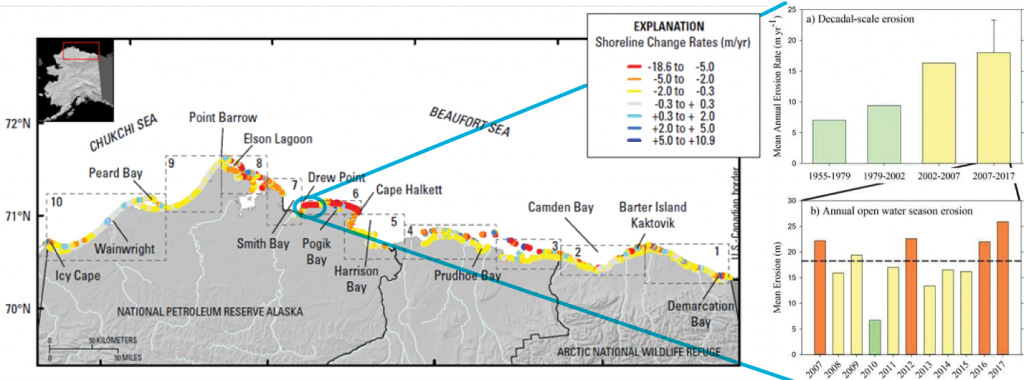Discover the Arctic Coastal Erosion (ACE) Model
Overview
Read an overview of the ACE Model and its purpose.
Why the ACE Model?
Learn about the unique features and applications of the ACE Model.
About the ACE Model
Explore the ACE Model’s framework and development and download the ACE Model report.
Future Development
Discover what’s next for the ACE Model.
Current Applications
See examples of how the ACE Model is currently being applied.
Erosion in the Arctic
Glimpse the research documenting erosion in the Arctic and its impact.
Contact
Contact the ACE Model developers.
Publications and Video
Browse select publications and videos.
Overview
Although the Arctic comprises one-third of the global coastline and has some of the fastest eroding coasts, current tools for quantifying permafrost erosion are unable to explain episodic, storm-driven erosion events. Models developed for the lower latitudes have limited applicability because ice in permafrost acts as the consolidating material, making erosion in the Arctic fundamentally a thermal-chemical-mechanical process.
The Arctic Coastal Erosion (ACE) Model provides a field-validated, predictive model of thermal-chemical-mechanical erosion for the Arctic coastline. The ACE Model is created to solve the limitations of current coastal erosion tools.

Why the ACE Model?
The ACE Model and experimental results offer the most comprehensive and physically grounded treatment of Arctic coastal erosion available in the literature, dramatically improving scientist’s ability to predict circum-Arctic erosion.
This work can be used to inform scientific understanding of coastal erosion processes, contribute to estimates of geochemical and sediment land-to-ocean fluxes, and facilitate infrastructure susceptibility assessments. Ultimately, this will help scientists and policy makers better respond to current coastline loss in Alaska and prepare for any occurrences in the future.
The ACE Model was developed in partnership with the University of Alaska Fairbanks, Integral Consulting, the University of Texas at Austin, and the United States Geological Survey (USGS). This initial development and application of the ACE Model at Drew Point, AK with partners listed above was sponsored by the Laboratory Directed Research and Development program at Sandia.
About the ACE Model
The ACE Model consists of oceanographic and atmospheric boundary conditions that force a coastal terrestrial permafrost environment in Albany (a multi-physics based finite element model). An oceanographic modeling suite (consisting of WAVEWATCH III, Delft3D-FLOW, and Delft3D-WAVE) produce time-dependent surge and run-up boundary conditions for the terrestrial model.
In the terrestrial model, a coupling framework unites the thermal and mechanical aspects of erosion. 3D stress/strain fields develop in response to a plasticity model of the permafrost that is controlled by the frozen water content determined by modeling 3D heat conduction and solid-liquid phase change. This modeling approach enables failure from any allowable deformation (block failure, slumping, etc.).
Extensive experimental work has underpinned the ACE Model development including field campaigns to measure in situ ocean and erosion processes, strength properties derived from thermally driven geomechanical experiments, as well as extensive physical composition and geochemical analyses enabling estimation of organic matter fluxes into the ocean.

A comprehensive report detailing the development of each component of the ACE Model can be downloaded here:
Download the Arctic Coastal Erosion: Modeling & Experimentation Report
Future Development of the ACE Model
A quantitative validation study in which the ACE Model predictions are compared to available observational data collected during the 2018 and 2019 summer seasons will be the subject of a subsequent publication. Future work will also include the addition of two boundary conditions active at the niche formation:
- dynamic ocean water pressure boundary condition expected to alter the state of stress at the bottom of the bluff, and
- a boundary condition representing salinity-based melting at the portion of the bluff face exposed to the ocean.
Further calibration and sensitivity studies will also be carried out using a range of environmental, geomorphological and numerical parameters.
Longer term, our objective is to use the ACE Model as the microscale component of a multi-scale analysis, in which a statistical meso-scale treatment employs a ”catalog” of microscale results to account for the heterogeneity present along Arctic coastlines.
Current Applications
The InteRFACE Project
The ACE Model is currently being applied in the Department of Energy’s (DOE’s) InteRFACE (Interdisciplinary Research for Arctic Coastal Environments) project. InteRFACE, led by Los Alamos National Laboratory, aims to quantify and reduce uncertainties in our fundamental understanding of the magnitude, rates, and patterns of change along the Arctic coast by integrating leading expertise and new datasets on Alaska and Arctic social-environmental systems with long-championed DOE leadership in data and model analysis, coupled Earth System model development, and modeling of co-evolutionary pathways of human and natural systems. Sandia will be estimating erosional fluxes by applying idealized terrestrial coastlines subject to varying oceanographic boundary conditions in the ACE Model.
Erosion in the Arctic

Rising temperatures (atmosphere, ocean, and permafrost) (Arctic Report Card, 2018), declining sea ice (Overland et al. 2018), and longer ice-free seasons resulting in more energetic Arctic oceans (Barnhart et al., 2014), are all coupling to increase the vulnerability of Arctic coasts to erosion. Over the 21st century, multiple Arctic coastal sites have experienced increased erosion, with a few experiencing 20 meters of erosion in a single year (Jones et al., 2018), making those some of the fastest eroding coasts in the world.

Increasing Arctic coastal erosion rates have put critical infrastructure and native communities at risk while also mobilizing ancient organic carbon into modern carbon cycles. In terms of Alaska, this loss of coastline threatens six active U.S. Defense Department sites (DoD, 2016) and 30 coastal villages (USGAO, 2009). The economic impact of coastline loss in northern Alaska could total $1 billion (USGAO, 2009). In addition, coastal erosion represents a significant pathway for carbon and nitrogen trapped in permafrost to enter modern biogeochemical cycles (estimated to be similar in magnitude to riverine export into Arctic Ocean), where it may fuel food webs and greenhouse gas emissions in the marine environment (Bristol et al., 2021).
More Information
Contact
Diana Bull
dlbull@sandia.gov
Publications
Frederick, J., Mota, A., Tezaur, I., & Bull, D. (2021). A thermo-mechanical terrestrial model of Arctic coastal erosion. Journal of Computational and Applied Mathematics, 397, 113533.Bristol, E. M., Connolly, C. T., Lorenson, T. D., Richmond, B. M., Ilgen, A. G., Choens, R. C., Bull D.L., Kanevskiy M., Iwahana G., Jones B.M., & McClelland, J. W. (2021). Geochemistry of coastal permafrost and erosion-driven organic matter fluxes to the Beaufort Sea near Drew Point, Alaska. Frontiers in Earth Science, 8, 639.Bull, D.L.,E.M. Bristol, E. Brown, R.C. Choens, C.T. Connolly, C. Flanary, J.M. Frederick, B.M. Jones, C.A. Jones, M. Ward Jones, J.L. Kasper, J.W. McClelland, A. Mota, I. Tezaur (2020). Arctic Coastal Erosion: Modeling and Experimentation, SAND2020-10223, Sandia National Laboratories, NM.Thomas, M. A., Mota, A., Jones, B. M., Choens, R. C., Frederick, J. M., & Bull, D. L. (2020). Geometric and material variability influences stress states relevant to coastal permafrost bluff failure. Frontiers in Earth Science, 8, 143.Jones, B. M., Farquharson, L. M., Baughman, C. A., Buzard, R. M., Arp, C. D., Grosse, G., Bull, D.L., Günther, F., Nitze, I., Urban, F. and Kasper, J.L., Frederick, J., Thomas, M. A., Jones, C., Mota, A., Dallimore, S., Tweedie, C., Maio, C., Mann, D., Richmond, B., Gibbs, A., Xiao, M., Sachs, T., Iwahana, G., Kanevskiy, M., & Romanovsky, V. E. (2018). A decade of remotely sensed observations highlight complex processes linked to coastal permafrost bluff erosion in the Arctic. Environmental Research Letters, 13(11), 115001.Frederick, J. M., Thomas, M. A., Bull, D. L., Jones, C., & Roberts, J. (2016). “The Arctic Coastal Erosion Problem,” Sandia National Laboratories, SAND Report SAND2016-9762.
Videos
Video of Arctic coastline at Drew Point, AK | Video credit: Ben Jones, University of Alaska Fairbanks